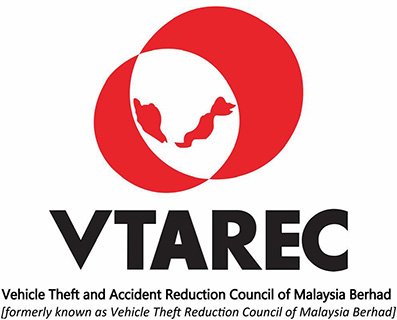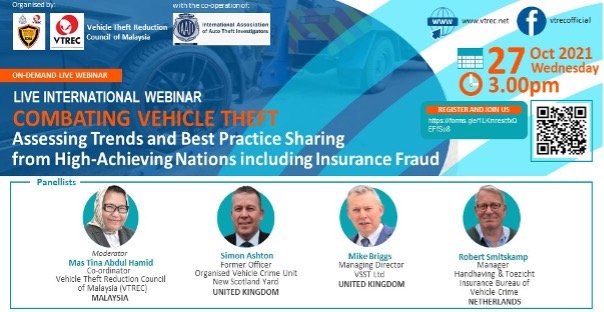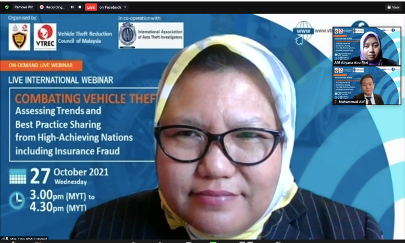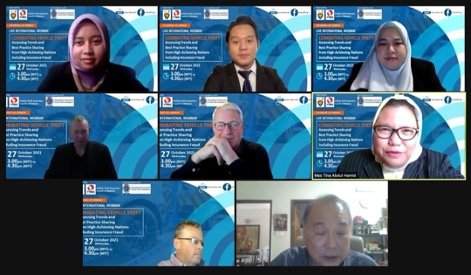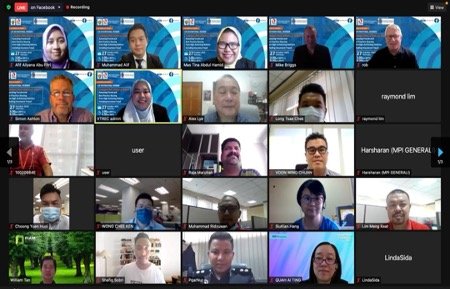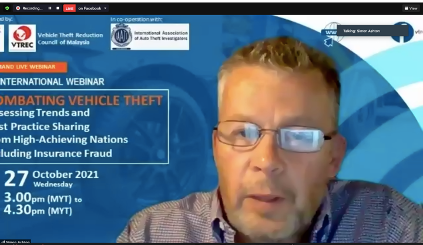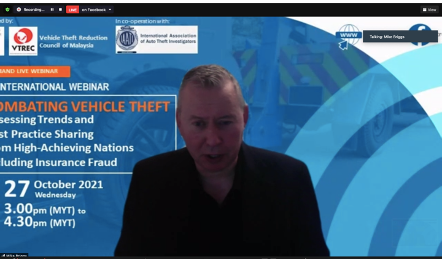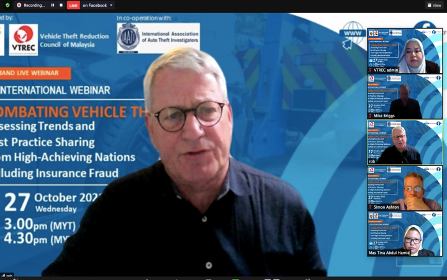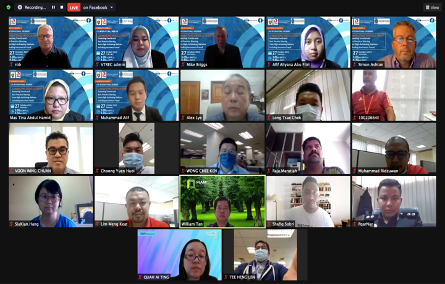KUALA LUMPUR, 27 October 2021: The Vehicle Theft Reduction Council of Malaysia (VTREC) with International Association of Auto Theft Investigations (IAATI) embarked on a collaboration in organising a live webinar entitled“Combating Vehicle Theft – Assessing Trends and Best Practice Sharing from High-Achieving Nations including Insurance Fraud”. The webinar was hosted by VTREC as part of VTREC’s role in engaging the stakeholders in combating the vehicle theft crime in Malaysia.
Moderated by Puan Mas Tina Abdul Hamid – VTREC’s Co-Ordinator
The moderator of the event Puan Mas Tina begins the session by welcoming all the participants, a brief introduction, highlighting the objectives of the webinar and introducing the panellists line-up. Puan Mas Tina during her brief introduction of the webinar session, captured the participant’s attention by bringing forward the overview statistics of vehicle theft in Malaysia for year 2019-2020.
She highlighted that the total number of vehicle theft in Malaysia reduce by 30% from 30,868 in year 2019 to 21,578 in 2020 however the biggest factor in the reduction might be because of the Movement Control Order (MCO) due the global pandemic Covid-19. Puan Mas Tina also shared the possible scenarios of stolen vehicle in Malaysia, the vehicle could either be resold, smuggled, cloned or stripped.
Puan Mas Tina Abdul Hamid, VTREC Co-ordinator cum Moderator of the webinar, giving her final briefing to all panellists and technical team prior webinar session
Among the participants of the webinar
The event’s aims were to provide information and best practice sharing on combating vehicle theft and fraudsters from high achieving nations, specifically from UK and Netherlands. The webinars also discussed problems of vehicle theft, cloned vehicles and insurance frauds including vehicle theft prevention. The discussion of the webinar includes sharing the latest information on state or government initiatives on information systems that track and identify vehicles, latest information on state or government legislation and law and latest information about improved vehicle technology.
The panellists line-up were:
- Mr Simon Ashtons, former officer of Organised Vehicle Crime Units in New Scotland Yard, United Kingdom. Mr Ashtons had a direct and unique responsibility to work with vehicle manufactures and insurers. He is an expert recognising the risk posed to the motor industry from vehicle theft and fraud.
- Mr Mike Briggs, Managing Director, VSST Limited (former Vehicle Security Manager of Thatcham Research, United Kingdom) who had working experience of over 39 years in the automotive industry and 22 years of it is being at the insurer’s research centre. Mr Briggs led his team for many years, opening new paths while developing new ideas and solutions for vehicle theft prevention as well as vehicle security on a global scale.
- Mr Robert Smitskamp who is a Law Enforcement Manager in Insurance Bureau of Vehicle Crime in Netherlands. Mr Smitskamp has 23 years of experience in fraud claims handler for insurance company and has been working for the foundation Insurance Bureau for 13 years, tackling vehicle crime, investigation cash for crash claims for all insurance companies, recuperations of vehicle and working close together with the police in investigations.
Mr. Simon Ashtons, Former Officer Organised Vehicle Crime Units, New Scotland Yard, United Kingdom
The First Panellist, Mr Simon Ashton speaks about how the police identify current method and modern devices used for vehicle theft and how they recognize the risk, harm and threat from insurance fraud. He first shared how the organisation, Vehicle Crime Units started looking at the vehicle theft crime as a whole and try to understand it in a different angle after a series of arresting thieves and recovering vehicles, they decided to start approaching it in a different way because after all, “prevention is better than cure” he said.
They started analyzing why and how particular vehicles were stolen and in what numbers. It was then, they discover that the vehicles were stolen for a specific purpose and it runs and profit like a business. There are three reasons for stolen vehicles, number one, it feeds foreign market. Number two, it’s cloned to a different vehicle and number three, to strip for parts. The Vehicle Crime Units were also responsible to expose the police with how the items were stolen and what they need to look for when the vehicles were recovered. They also introduced dead lock and immobilizer in vehicle which then lead to an immense reduced in the vehicle theft crime.
Mr Mike Briggs, Managing Director VSST Limited (former Vehicle Security Manager of Thatcham Research, United Kingdom)
Mr Mike Briggs first and foremost introduced his organization VSST which stands for Vehicle Security Solutions Today which was actually formed with the request of the UK Government and National Chief Police Council. The aim was to try and bring together tracking system called TASSA in the automotive industry into a database for a better future policing in terms of tracking, health and safety, public safety, data access and liability.
Mr Briggs then shared a few statistics on number of reported theft where the peak number was up to 600,025 units of stolen vehicle in UK in 1990 that was when the UK Government decided to put this issue under insurance industry. The industry did whatever they could including forming the VSST and they were able to bring number down slowly every year until the lowest number is 75,000 units in 2015. However, in 2019, the number got up again, he believe was due to the advancement technology accessible to the theft criminal. He then talked about the technology changes in vehicle from the earlier time which was just a simple key and has progressed all the way to now only using phone to lock your car. Mr Briggs and his team ways of controlling the rise of vehicle theft crime were one of it is predicting the criminal’s next move through their MO called Vehicle Security Intelligence.
In the webinar he also shared that they had discovered the keyless theft equipment in UK in 2010, then shared a graph showing the amount of time taken to steal a car which reduced over the years with new advancement of technology being accessible to the criminal. He said that the latest they discovered in 2017, it only takes up to 20 second for a thief to steal a car. Before ending his session, Mr Briggs shared the timeline that he and his team has come up with to counter theft measures aftermarket and the technology standards. He said the important thing is for the enforcement agencies to be kept updated to the latest technology used by the thieves.
Mr Robert Smitskamp, Law Enforcement Manager Insurance Bureau of Vehicle Crime in Netherlands.
Mr Smitskamp shared among others, the role of the Insurance Bureau in Netherlands and in which way the government agencies were able to control the repair shops, car handlers or demolish companies in order to combat the theft frauds as well as tackling the vehicle theft crime. He also shared the statistics of vehicle theft in different parts of Netherlands and shared that in Netherlands the most popular car model stolen is Volkswagen which is also the highest number of sold model as well. Mr Smitskamp before ending his session shared some of the system used in Netherlands and how the insurance bureau and police department worked closely together in tackling vehicle theft crime in Netherlands.
Among the Participants of the webinar
The event ended smoothly with around 300 participants joining in the zoom meeting room as well as joining through the Facebook Live. During the event, there were many questions forwarded by the participants for panellists to answer among others were about what the legal actions taken against vehicle theft criminal in UK and Netherlands, what kind of advanced system used by the police in UK that can be implemented in Malaysia, what are the statistics of smuggling and cloned vehicles crime in Netherlands and many others.
Participants were very active throughout the whole webinar session asking questions which shows attentive listening to all the sharing that have been put forward by all the panelists. The webinar came to an end with a Group Photo session after all the panellists have said their final words and a simple wrap up from the moderator.
VTREC thanked the panellists and all participants for their collaboration and their active participation for making the webinar a success.
